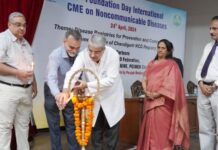Empowering India’s Electric Vehicle Renaissance
Dr. Mahendra Nath Pandey
Dr. Mahendra Nath Pandey
Union Minister, Ministry of Heavy Industries
At the vanguard of India’s industrial growth, the Ministry of Heavy Industries (MHI) champions the advancement of three pivotal sectors: Capital Goods, Automobile, and Heavy Electrical Equipment. Through visionary initiatives like the Faster Adoption and Manufacturing of Electric Vehicles (FAME-II) scheme, MHI pledges to usher in a new era of clean and green public transportation. With an overarching goal to diminish reliance on fossil fuels and combat vehicular emissions, FAME-II underscores the government’s commitment to sustainable mobility. Additionally, the Production Linked Incentive (PLI) Auto and Auto Components scheme, spearheaded by MHI, epitomizes India’s ambition to elevate its manufacturing prowess and bolster exports in the automotive sector. By fostering deep localization, economies of scale, and a resilient supply chain in Advanced Automotive Technology (AAT) products, MHI propels India towards self-sufficiency and global competitiveness.
Aligned with Prime Minister Shri Narendra Modi’s vision of an Atmanirbhar (self-reliant) and Viksit (developed) Bharat, MHI steers India towards a future characterized by innovation and resilience. Embracing the imperative to achieve net-zero emissions by 2070, as articulated by Prime Minister Modi, MHI places electric vehicles (EVs) at the forefront of India’s sustainability agenda.
Cells – the heart of electric vehicles
Advanced chemistry cells emerge as the fulcrum in the progression of electric vehicles (EVs), orchestrating a symphony of performance, efficiency, and range. Lithium-ion and solid-state batteries stand as epitomes of innovation, offering superior energy densities, expedited charging times, and fortified safety protocols vis-à-vis their conventional counterparts. The development of these advanced cells is indispensable for surmounting EV constraints such as range anxiety and protracted charging intervals, thus fostering widespread consumer embrace and adoption. Moreover, breakthroughs in chemistry engender the creation of feathery and more streamlined battery packs, culminating in reduced vehicle mass and heightened operational efficiency. Indeed, advanced chemistry cells emerge as the cornerstone of a sustainable electric transportation ecosystem.
In her address during the interim budget presentation, Finance Minister Nirmala Sitharaman unveiled a comprehensive strategy aimed at invigorating the electric vehicle (EV) sector. This aligns closely with Prime Minister Narendra Modi’s overarching vision for sustainable development. Emphasizing the government’s commitment to fortifying the EV ecosystem, she outlined initiatives focused on bolstering both manufacturing capabilities and charging infrastructure. These commitments, echoing India’s pledge to address global climate change as articulated during the COP26 summit, underscore the government’s dedication to both national progress and international environmental stewardship. Furthermore, with India’s ambitious goal to achieve net zero emissions by 2070, alongside aspirations to emerge as a global champion in the automobile sector, these initiatives serve as integral steps toward realizing multifaceted objectives encompassing environmental sustainability and economic prowess.
In the unfolding narrative of automotive evolution, diverse battery technologies vie for prominence, each wielding unique attributes and capabilities. Lithium-ion batteries, celebrated for their potency and longevity, reign supreme as the nucleus of EV propulsion. Nevertheless, the innovation continuum encompasses a plethora of promising alternatives, reshaping the electric mobility panorama. Lithium iron phosphate (LiFePO4) batteries emerge as sentinels of safety and thermal resilience, outshining traditional Li-ion counterparts.
Beyond Lithium Ion
Beyond the confines of lithium, alternative battery technologies burgeon, signifying potential pathways to affordability and resource abundance. Sodium-ion batteries, leveraging abundant sodium ions, present a compelling case for cost-effective energy storage solutions.
The transformative potential of advanced chemistry cells finds resonance in the monumental strides taken by India’s industrial landscape. The government’s visionary policies, exemplified by the technology-agnostic PLI Scheme for the ‘National Programme on Advanced Chemistry Cell (ACC) Battery Storage’, envisage the establishment of a robust manufacturing ecosystem. With an audacious target of attaining a manufacturing capacity of Fifty (50) Giga Watt hours (GWh) of ACC, India’s foray into battery storage solutions attains a new zenith. The successful culmination of the ACC PLI bidding, coupled with strategic partnerships forged with leading industry players, heralds a new dawn in India’s journey towards energy sovereignty.
Fast tracking Government support though PLI
MHI’s recent announcement regarding the re-bidding of Production Linked Incentives (PLI) for 10 GWh Advanced Chemistry Cell (ACC) manufacturing epitomizes the government’s unwavering commitment to fostering indigenous innovation. As prospective applicants gear up to vie for incentives under the PLI ACC scheme, India braces itself for a quantum leap in domestic manufacturing prowess. With another 10 GWh tranche slated for imminent realization, India’s vision of achieving a cumulative capacity of 50 GWh for ACC production inches closer to fruition.
Furthermore, the cascading effect of government initiatives augurs well for India’s burgeoning EV ecosystem. A burgeoning ecosystem nurtured by the PLI ACC scheme sets the stage for an influx of private investment and innovation. Envisioning an augmented capacity of 60-80 GWh through private endeavors underscores India’s ascension as a global leader in electric vehicle technology.
India stands poised on the cusp of an electric vehicle renaissance, fueled by the transformative potential of advanced chemistry cells. As the nation charts a course towards self-sufficiency and environmental stewardship, the convergence of visionary policies and technological innovation paves the way for a sustainable and prosperous future.














